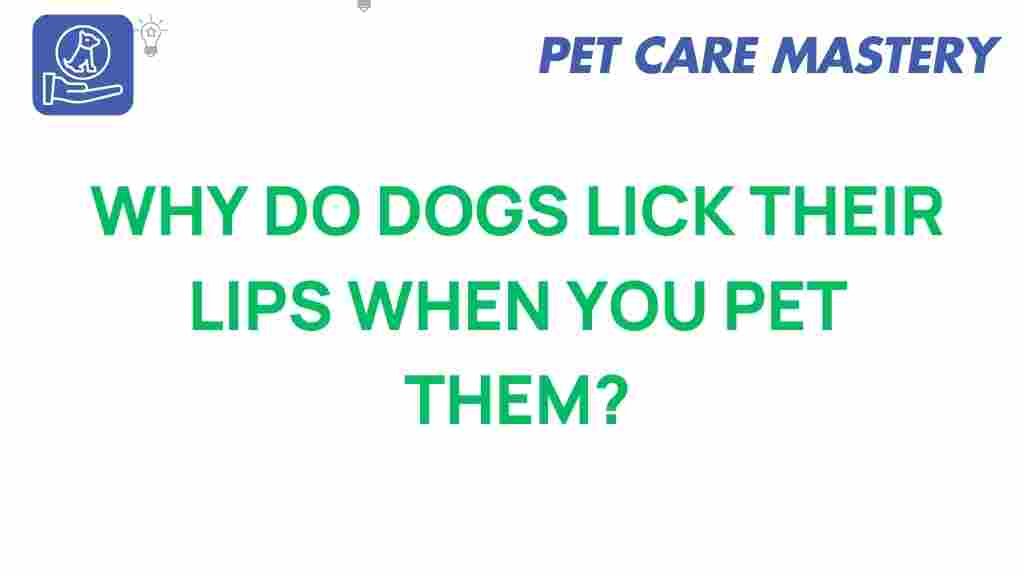Understanding Dog Behavior: The Intriguing Reasons Behind Your Dog’s Lip Licking When Petted
As dog owners, we often interpret our furry friends’ actions through our own lens. One common behavior that can leave us puzzled is lip licking when we pet our dogs. This seemingly simple action can have multiple meanings and is an essential aspect of dog behavior. Understanding why your dog licks its lips can enhance your bond and improve communication between you and your pet.
What is Dog Behavior?
Dog behavior refers to the various ways dogs express themselves through body language, vocalizations, and physical actions. Just like humans, dogs have their own unique ways of communicating feelings and emotions. Recognizing these behaviors is crucial for any dog owner to ensure their pet’s well-being.
Why Do Dogs Lick Their Lips?
When you pet your dog and it starts licking its lips, it can indicate a variety of emotions or needs. Here are some of the most common reasons behind this behavior:
- Relaxation: Lip licking can signify that your dog is feeling relaxed and comfortable. If your dog licks its lips while being petted, it may be a sign that it enjoys the interaction.
- Stress or Anxiety: Conversely, lip licking can also indicate stress or anxiety. If your dog is in an unfamiliar environment or feeling overwhelmed, it might lick its lips as a self-soothing mechanism.
- Communication: Dogs often use lip licking to communicate with other dogs and humans. It can be a way of showing submission or appeasement, especially if they feel threatened or unsure.
- Hunger or Thirst: If it’s been a while since your dog has eaten or had water, lip licking can indicate that it is hungry or thirsty.
- Health Issues: Sometimes, excessive lip licking might signal a health concern, like dental problems or nausea. If the behavior persists, it’s best to consult a veterinarian.
Step-by-Step Process: Observing and Understanding Your Dog’s Behavior
To effectively understand your dog’s lip licking behavior, it’s essential to observe their actions in context. Here’s a step-by-step process to help you analyze the situation:
Step 1: Observe the Environment
Take note of where you are when your dog is licking its lips. Is it in a familiar space or somewhere new? Is there any loud noise or other animals around? The environment can significantly influence dog behavior.
Step 2: Assess Your Dog’s Body Language
Look for other signs of dog behavior that accompany lip licking. Is your dog relaxed with a wagging tail, or is it tense with raised hackles? Body language is often a key indicator of what your dog is feeling.
Step 3: Consider the Timing
Pay attention to when the lip licking occurs. Does it happen right after you start petting your dog, or does it occur after a stressful event, like a loud noise? Timing can provide insights into the cause of the behavior.
Step 4: Evaluate the Duration
How long does your dog lick its lips? Brief licking may be normal, but if it continues for an extended period, it may warrant further investigation.
Step 5: Reflect on Past Experiences
Consider any recent changes in your dog’s life, such as new surroundings, changes in routine, or introductions to new people or pets. All of these factors can influence your dog’s behavior.
Troubleshooting: When to Seek Help
While lip licking is often a normal part of dog behavior, there are times when it might indicate a more serious issue. Here are some signs that you should consult a veterinarian:
- Persistent or excessive lip licking that lasts for more than a few minutes.
- Signs of discomfort, such as whining or pawing at the mouth.
- Changes in eating or drinking habits.
- Unusual drooling or bad breath.
- Other symptoms like vomiting, diarrhea, or lethargy.
It’s always better to err on the side of caution. Your veterinarian can help rule out any medical issues and provide advice on managing your dog’s behavior.
Conclusion: Enhancing Your Bond Through Understanding
Understanding your dog’s behavior, especially lip licking, is crucial for fostering a healthy and loving relationship. By paying attention to the context, body language, and environment, you can better interpret what your dog is trying to communicate. Remember, every dog is unique, and their behaviors can vary widely based on personality and experience.
Next time you notice your dog licking its lips while being petted, take a moment to observe and reflect on the situation. This level of awareness can not only improve your understanding of your dog but also strengthen the bond you share. For more insights into dog behavior, consider visiting resources like The American Kennel Club or our own articles on canine communication here.
This article is in the category Behavior and created by PetCareMastery Team
